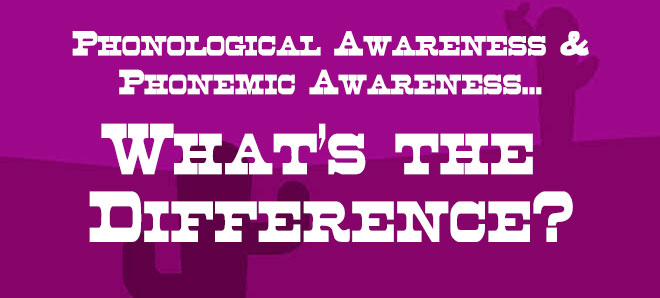Phonological Awareness and Phonemic Awareness
Phonemic awareness and phonological awareness are two critical skills that children need to develop to become successful readers. These terms are often used interchangeably, but they are not the same thing. Phonemic and phonological awareness refer to two different skills children must acquire as they learn to read.
What is Phonological Awareness
Phonological awareness is the broader term of the two, which refers to a child’s ability to recognize and manipulate the sounds of spoken language. It involves understanding the sound structures in language, including syllables, onset and rime, and phonemes. Children with strong phonological awareness can identify and manipulate sounds in words, such as rhyming words or blending individual sounds to form a word.
A child’s phonological awareness is essential to early literacy and language development. It enables them to distinguish between different sounds in words and recognize patterns. Furthermore, it improves their reading and spelling skills by giving them the ability to “hear” the sounds that makeup spoken words.
With strong phonological awareness, children can better recognize and decode words while reading. They are more likely to understand what they’re reading if they can break down words into sounds because it gives them more context. And if they can distinguish between the various sounds in a word, they can more easily spell it.
Phonemic Awareness and Phonological Awareness
Both phonemic awareness and phonological awareness are essential skills for reading development. Children who struggle with these skills often experience difficulty learning to read and may require additional support and intervention to develop these skills.
Research has shown that phonemic awareness is the most critical predictor of early reading success. Children who have strong phonemic awareness skills are better able to decode words, read fluently, and comprehend what they read. In contrast, children who struggle with phonemic awareness are more likely to experience difficulties with reading and may require remedial support.
It is important to note that phonemic awareness is a subset of phonological awareness, and a child must have a strong foundation in phonological awareness before developing strong phonemic awareness skills. Therefore, when teaching phonemic awareness, it is essential to ensure that children have a solid understanding of the broader concept of phonological awareness.
What is Phonemic Awareness?
Phonemic awareness, on the other hand, is a subcategory of phonological awareness. It refers specifically to a child’s ability to hear, identify, and manipulate individual sounds, or phonemes, in words.
Phonemic awareness is essential for reading because it helps children to decode words by breaking them down into their individual sounds and then blending them back together.
To illustrate the difference between these two concepts, consider the following example. A child with strong phonological awareness can recognize that the words “cat” and “bat” have the same ending sound, or rime. They can also identify the beginning sound, or onset, of each word. This is an example of phonological awareness.
In contrast, a child with strong phonemic awareness can take the word “cat” and break it down into its individual sounds: /k/ /a/ /t/. They can then blend those sounds back together to form the word “cat.” This is an example of phonemic awareness.
Method of Instruction
Research has shown that using a systematic, explicit phonics method is the best way to teach these skills. Systematic, explicit phonics instruction is the basis of the Reading Ranch Method™ and is part of every program at The Reading Ranch.
In conclusion, phonemic awareness and phonological awareness are two critical skills that children must develop to become successful readers. Phonological awareness refers to a child’s ability to recognize and manipulate the sounds of spoken language, while phonemic awareness specifically relates to the ability to identify and manipulate individual sounds in words. Both skills are essential for reading development, but phonemic awareness is the most critical predictor of early reading success. When teaching phonemic awareness, it is important to ensure that children have a strong foundation in phonological awareness. Strong phonemic and phonological awareness skills are essential for a child’s reading success.


